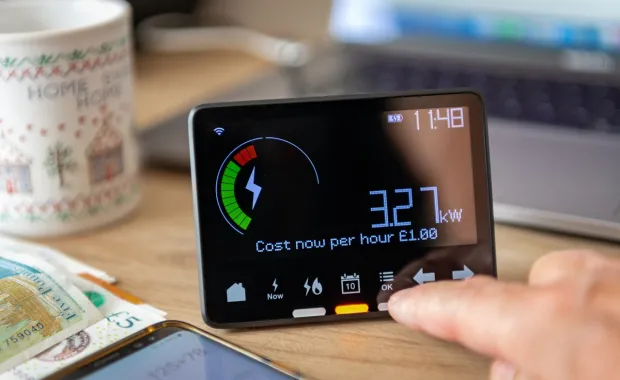A colleague of mine often talks about the energy transition by mis-quoting Star Trek’s Montgomery Scott: “Ye cannae change the laws of physics, or even the laws of electrical engineering, but the energy transition changes the dynamics of the electricity system, fundamentally.”
The electricity system is undergoing a fundamental transformation, shifting from centralised, dispatchable generation to a distributed model. One where supply depends on time of day and weather conditions, and where flexibility must increasingly also come from the demand side. This shift is more than a technical engineering challenge. As the Department for the Economy’s (DfE) latest Action Plans and consultations make clear, the energy transition is also a strategic opportunity. To meet the 2030 target of 80% renewable electricity and achieve net zero by 2050, Northern Ireland must reinvent its energy system to be digital, flexible, and citizen focused.
To maximise the opportunity, we need to take a holistic view of the energy system that considers more than the relationship between electricity, gas, heat and hydrogen. We must also consider governance, investment and the wider societal opportunities generated by the transition. Given the pivotal role the electricity system will play in our future decarbonised world, NIE Networks (Northern Ireland Electricity Networks) is uniquely positioned to lead the necessary collaborative effort across the wide range of stakeholders involved.
Beyond infrastructure: Digital foundations and system intelligence
Whilst the energy transition presents a monumental physical engineering challenge, it must go hand-in-hand with deep digitalisation to deliver operational visibility across the system. This will offer broad benefits from strategic planning and investment to optimising infrastructure and reducing costly upgrades. Applying AI and Machine Learning to predict maintenance requirements can improve field-force productivity and reduce outages. Consumers can also benefit from participation in flexibility markets and dynamic tariffs that reflect the real cost of electricity.
Delivering this vision of a democratised energy system, where value is fairly attributed between system actors and investment aligns with system needs, requires whole system visibility through timely and equitable access to data in a common, consistent format.
The opportunity for Northern Ireland
As NIE Networks becomes more data-led in its decision-making, the opportunity to optimise planning, operations and customer engagement is enormous. Digitalisation isn’t just an enabler; it delivers the central nervous system of a future energy system.
NIE Networks' £2bn RP7 business plan lays the foundation, enabling physical upgrades to support decarbonised supply. However, as highlighted in the DfE's Design considerations for a Northern Ireland Smart Systems and Flexibility Plan (SSFP), digitalisation must deliver real-time visibility, smart control, and automation across a two-way grid.
Flexibility as the cornerstone of energy resilience
As fossil fuel generators retire, and demand increases through the electrification of transport and heat, the imperative to access demand flexibility is essential to maintain resilience. That means from large-scale batteries, interconnectors to smart EV (Electric Vehicle) charging and from consumer demand response.
Northern Ireland’s upcoming smart metering programme will enable consumers to benefit from allowing their flexible demand to participate in the energy system. The evolving role of NIE Networks, from traditional network to active system operator, hinges on the ability to utilise flexible demand. This includes developing transparent market access for consumer energy resources (CERs). This evolution must happen in close coordination with SONI and the Utility Regulator.
The consultation on design considerations for a Northern Ireland SSFP explores how regulatory and operational changes can unlock these services. For NIE Networks, the ability to utilise modern control systems, integrated data platforms and secure analytics is critical. CGI has supported clients with the deployment of these capabilities through our digital grid programmes, enabling operators to transition confidently into Distribution System Operator (DSO) roles.
Unlocking alternative renewable sources
The future of energy isn’t just electric-only. For instance, Biomethane could decarbonise 80% of current gas demand and enhance the resilience of rural communities. Northern Ireland’s modern gas infrastructure is ready for biomethane and potentially hydrogen, supporting industrial decarbonisation and system balancing. DfE’s actions to support green gas pathways are underway, and CGI’s experience of operating in European markets informs how gas and electricity can be strategically integrated.
A people first approach
The transition required is more than just a technical challenge, it's societal. Consumers will shift to active participants in the system. The challenge is to ensure an inclusive transition, one where those in fuel poverty, rural homes or with accessibility needs are also able to access the benefits and are not left behind. Projects such as the Energy One Stop Shop and the Community Energy Pathfinder are encouraging, but scaling these initiatives will require strong digital public services, interoperable platforms and trust.
Northern Ireland’s compact system provides the opportunity to design and implement whole-system strategies. But agility must be matched by capability. With expertise spanning energy operations, flexibility markets, regulation and cybersecurity, CGI is well positioned to help Northern Ireland develop tailored models that meet unique requirements and customer needs.
Transition to transformation
Northern Ireland has the ambition, strategy, and a strong platform in place. What’s now needed is precise execution of data, collaboration and delivery across system integration, energy vectors, and stakeholders.
The ultimate measure of a successful energy transition will be how seamless it feels. If the public continues to benefit from reliable power supply and improved services, many may not realise that the sector will have delivered one of the largest infrastructure projects in over a century, laying the foundation to deliver our climate commitments.
To find out more please get in touch or visit our Energy networks page.
* This blog is based on the article Navigating Northern Ireland’s energy transition originally published by AgendaNI.








